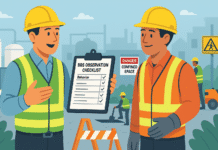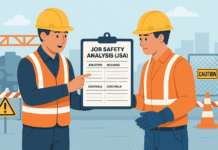
Basic Safety Questions and Answers Everyone Should Know
Safety is everyone’s responsibility. Whether you’re working on a construction site, in a manufacturing unit, or even at home, knowing basic safety can prevent accidents and save lives. Here are some of the most commonly asked safety questions—and the answers you should know.
1. What is Safety?
Answer:
Safety is the condition of being protected from harm or other non-desirable outcomes. In the workplace, it refers to the prevention of accidents and injuries through proper procedures, training, and awareness.
2. Why is Safety Important?
Answer:
Safety is important to protect employees from injury or illness, reduce absenteeism, improve productivity, and comply with laws and regulations. It creates a safer and more efficient working environment.
3. What is a Hazard?
Answer:
A hazard is anything with the potential to cause harm. Examples include chemicals, electricity, working at height, or even poor lighting.
4. What is Risk?
Answer:
Risk is the chance or probability that a hazard will cause harm. It considers both the likelihood and the severity of the consequences.
5. What is PPE?
Answer:
PPE stands for Personal Protective Equipment. It includes safety gear like helmets, gloves, goggles, safety shoes, earplugs, and reflective vests, used to protect workers from hazards.
6. Name Some Common Types of PPE.
Answer:
- Safety helmet
- Safety goggles
- Gloves
- Safety shoes
- Ear protection
- High-visibility vest
- Face shield
- Respirators
7. What is the First Step in Risk Assessment?
Answer:
The first step is identifying hazards. You need to find out what could cause harm in your workplace.
8. What Should You Do If You Find an Unsafe Condition at Work?
Answer:
Report it immediately to your supervisor or safety officer. Do not ignore it, even if you are not directly affected.
9. What is a Safety Sign?
Answer:
A safety sign is a visual sign used to indicate hazards, provide instructions, or show emergency exits. They help communicate safety information quickly and clearly.
10. What Are the Four Main Types of Safety Signs?
Answer:
- Prohibition Signs – Indicate things you must not do (e.g., No Smoking)
- Warning Signs – Indicate potential hazards (e.g., High Voltage)
- Mandatory Signs – Indicate things you must do (e.g., Wear Hard Hat)
- Emergency Signs – Indicate emergency exits or first aid
11. What Is Lockout/Tagout (LOTO)?
Answer:
LOTO is a safety procedure used to ensure that dangerous machines are properly shut off and cannot be started again before maintenance or repair work is completed.
12. What Should You Do Before Using Any Equipment or Machinery?
Answer:
- Inspect it for damage
- Check that safety guards are in place
- Make sure you are trained and authorized
- Wear appropriate PPE
- Follow standard operating procedures
13. What Is a Fire Triangle?
Answer:
The fire triangle is a model for understanding the ingredients needed for fire: Heat, Fuel, and Oxygen. Removing any one of these elements will prevent or extinguish a fire.
14. What Should You Do in Case of a Fire?
Answer:
- Raise the alarm
- Evacuate the area using the nearest exit
- Do not use elevators
- Only use a fire extinguisher if trained and safe to do so
- Report to the assembly point
15. What Is an MSDS or SDS?
Answer:
MSDS stands for Material Safety Data Sheet, now called SDS (Safety Data Sheet). It contains detailed information about the chemical substance, including hazards, handling, storage, and emergency measures.
16. How Can You Prevent Slips, Trips, and Falls?
Answer:
- Keep walkways clear
- Clean spills immediately
- Use anti-slip mats or tapes
- Wear proper footwear
- Keep lighting adequate
17. What Are the Common Causes of Workplace Accidents?
Answer:
- Unsafe behavior
- Lack of training
- Poor housekeeping
- Faulty equipment
- Not wearing PPE
- Ignoring safety procedures
18. What Is the Role of a Safety Officer?
Answer:
A safety officer monitors workplace environments, enforces safety policies, conducts safety training, investigates accidents, and ensures compliance with health and safety regulations.
19. What Is Toolbox Talk?
Answer:
A toolbox talk is a short, informal safety meeting focused on a specific topic relevant to the work being done. It helps reinforce safety awareness among workers.
20. What Should You Do If Someone Gets Injured?
Answer:
- Call for medical help immediately
- Do not move the injured person unless necessary
- Administer first aid if trained
- Inform the supervisor or safety officer
- Record the incident
Final Thoughts
Knowing basic safety principles can make a huge difference in preventing accidents and ensuring a secure environment for yourself and others. Whether you’re a fresher or a seasoned worker, never ignore safety—it’s your first responsibility on any job site.
Top 50 Safety Questions and Answers for Job Interviews
What Are the Top Safety Manager Interview Questions?
The Most Asked Safety Interview Questions for Candidates in 2024-2025
Process Safety Engineer: 50 Safety Job Interview Questions & Answers
Manufacturing Safety Officer: 50+ Safety Job Interview Questions & Answers

























Why can’t I see and read the questions and answers as I had hoped and expected?
Problem Solved